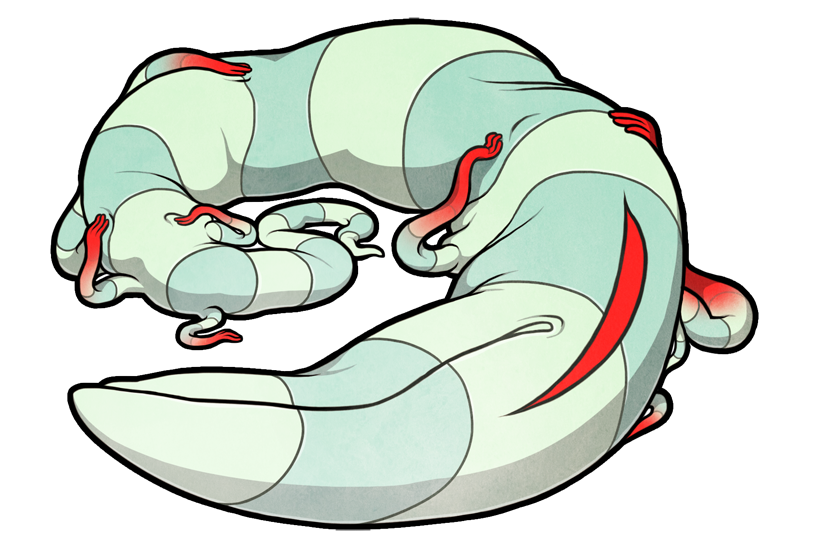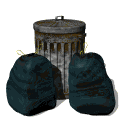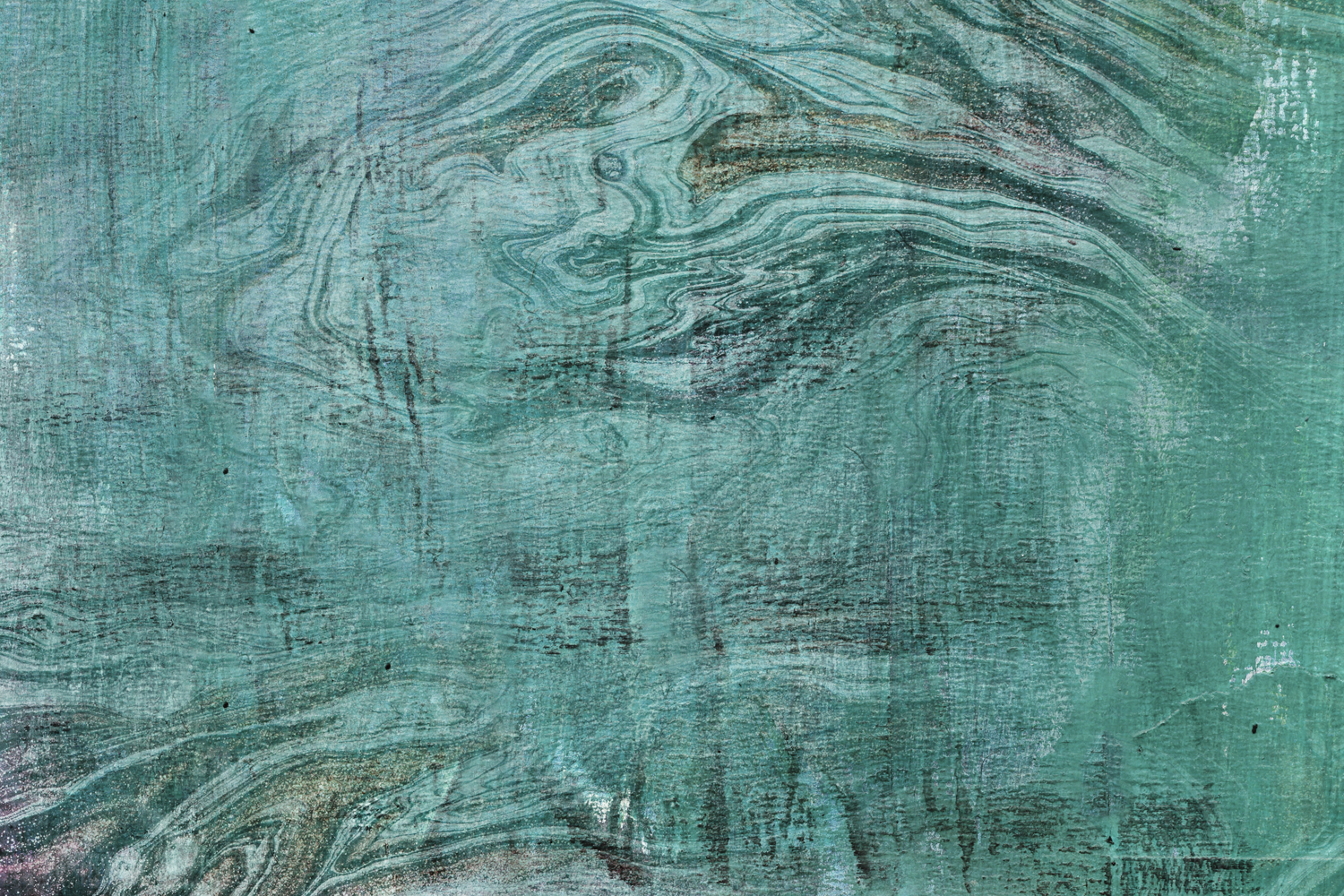

Thoradromi
the Pleasure Seekers
prefix thora suffix dromi
brimus carminii
physical appearance
The thoradromi /ˈθɔrədroʊmi/ is a pale green-to-blue stranger composed of a doughy, plasticine foam. Its body is stretchy, and the inner flesh is pure white, with no internal organs. Though the size, stripe width, shade, shape, and number of legs vary between individuals, thoradromi within a group tend to look alike.Ⴔ
Ⴔ But, they're not identical.
above: regardless of its hue, the effect remains the same.
The stranger's markedly artificial odor smells like cheap rubber, and its presence causes headaches, nausea, and shortness of breath. In addition, its flesh is a noted carcinogen, and even brief contact raises the risk of various cancers by up to 4.8%.
The thoradromi's body is soft enough that it can be cut with a butter knife, it is difficult to kill, owing to its notable regenerative ability. It recovers from most wounds within second; even direct exposure to flame causes only temporary charring. Sunlight, however, proves markedly detrimental to the strain; full exposure to direct sun proves fatal within thirty minutes, as the thoradromi's flesh bubbles, loses color, and dries out – even indirect light can trigger this response in degrees, although recovery remains near-instantaneous.
The thoradromi's voice is androgynous and soft, constrasting the disordered sounds and irregular cadenceტ of its words. The strain has no set language, and no two individuals share the same phonetic palette.
ტ In short... it's not pleasant to listen to.
Blalyflanx boldopy blaaan! Ablaaanx, tumboflanxy bolbone.

environment and generation
The thoradromi can be found in a wide variety of indoor and outdoor locations.ᶀ It generates in a shaded area 97% of the time, and nearly always against a fence or wall, with 45% appearing in corners. Within these dim locales, the nascent thoradromi grows with fitful bubbles from a wad of foam until it reaches full size, a process which can take anywhere between fifteen minutes and two weeks. It usually shows up in groups, which tend to reach maturity at around the same time.
ᶀ
a a room with the floor tiles ripped up, and the floral wallpaper still untouched.
b the footbridge between the museum and the parking garage.
c hospital's third floor waiting room, long vacated.
behaviour
The thoradromi possesses a lazy and inert disposition. It spends its life in a supineɩ position, conversing with its companions, or chattering away to itself. Locomotion remains perpetually unobserved; the thoradromi will not move even when exposed to direct sunlight, and instead, flails and pleas in plaintive articulations as its body sizzles.
ɩ It's able to move in theory, maybe, but...
Its laziness is matched only by its perverse desire to insert objects into its body, and it always picks up anyɭ object within reach. Its foamy inner flesh dissolves all matter absorbed into itself, with less dense matter dissolving at a faster rate; thus, while a piece of rebar may take weeks to dissolve, an apple deliquesces in under a minute. The thradromi is able to pick up any object equal to its own weight, even drags scrap metal, household appliances, and pieces of furniture into its body. Despite this, the strangers prefers objects which can be absorbed whole, as opposed to large items that it must insert in gradual pushes in order to dissolve entirely.
ɭ All the way down to tiny rocks and crumbs.
Each thoradromi has a specific kind of object it enjoys above all else, which can be as general as a book, or as specific as a red checker. It moans in pleasure when pressing this favored item inside of it, and lets out a slow shudder of contentment once the object is fully absorned. Should the shape allow it, the thoradromi often drives the object in and out of its body for several minutes in a kind of crude, self-stimulatory manner, as any companions look on, mouths open in voyeuristic shock.
It seems to make some unclear distinction between an object, and the room around it; carpets are not ripped up, and although posters may be torn down, wallpaper is not.
The thoradromi sings in unison with others of its strain, and always laughs when one of its companions is hurt or killed by exposure to sunlight. It is particularly social (or antisocial) when within arm's length of another of its kind; pairs of individuals sometimes push objects into one anther, or fight over coveted items.
delight towards the absorption of animals
Animals of all kindsẝ are of great interest to the thoradromi, and it always stretches out to grab at any that wanders into or is placed inside the room. It even seems to take a specific and great delight in snatching bugs out of the air, clenching its hand into a fist to absorb them into its palms. Should it get its hands upon a larger creature, it consumes the creature with overt and orgasmic joy, as its companions moal in an extension of the creature's cries, if any.
ẝ
a a monarch butterfly.
b a hazel dormouse.
c a one-eyed gray cat that watches from a distance.
interactions with sensitives
The thoradromi pounds its fists upon the ground, beckons with its fingers, and pushes its hands into its own body in an attempt to entice any sensitive that enters its territory. Its animal hunger turns bold, and once its intended prey is within range, it reaches forward with quick but deliberate grabs.
solutions you can't deny
uh-oh, can't get rid of the ... "by-products"?

have the shortcomings of "ethical" waste disposal methods left you with too much waste? you can finally feel clean again, when you learn about these un-zoned wetlands, "de-prioritized" urban areas, seasonal recreational facilities and even senior living homes can now be ...
Contact with the thoradromi's flesh is excruciating. It eats through muscle tissue at a rate of 0.3 inches per minute, leading to a quick death, and the thoradromi smashing its hands into the sensitive's cavities to speed up the process.
Upon successfully devouring a sensitive, the thoradromi displays both reliefᏑ and fatigue, and displays no interest in nearby objects, animals, or sensitives for the next two to five days. Its internal flesh turns bright red, and remains this shade for several weeks, as the area around its mouthი takes on a temporary reddened stain.
Ꮡ haven't you ever wanted to lose yourself?


until there's nothing left.
ი It just ate such a big meal. Do you really expect it to clean up its face?
This remarkable gratification is matched only by the stranger's agony should a sensitive escape its grasp. The unsuccessful predator lapses into rage, pounding at the ground and striking its companions and environment with whatever heavy objects it can, before it grows despondent and sullen until the next day.
aging and death
As the thoradromi ages, it loses its ability to dissolve objects, and its regenerative ability diminishes itself. Despite this, the thoradromi continues to push objects into itself, even when it inadvertently injures its own body in the process. A thoradromi that is unable to destroy itself eventually slows down and dies on its own.
Upon death, the corpse hardens into a foamy and inflexible substance, which nearby thoradromi, in rare bursts of dragging locomotion, move towards and tear up in chunks. They push these chunks into their bodies with a slow, sobbing shudder, which turns to laughter once all trace of the body disappears.
When not absorbed by its companions, the thoradromi's corpse breaks apart and decomposes on its own over the course of several months, leaving nothing behind but a pile of harmless, non-toxic grit.
they think it's safe. they called it "approved for elementary age children".

but do you know what's inside? let's get a microscrope: those look like tiny rocks and crumbs. When you get all the way down to it, it's not healthy. You want it to end now, stop these fat-cats from lining their pockets and feeding children dirt.

hey, we heard you like GAMES? but you can't play too many unless you have a "red checker".

but, they don't come just by themselves, do they? if you've lost something and you can't play the game... BUY IN, BUY IN, BUY IN »

